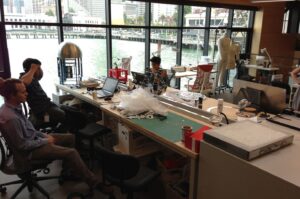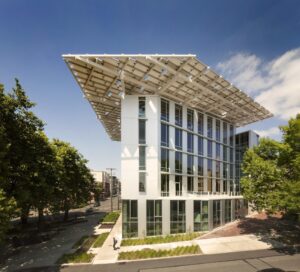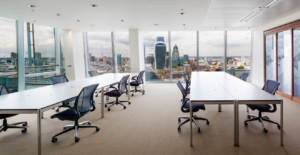As work evolves, it’s crucial to understand the new paradigms shaping our workplaces. Welcome back to our Unworking Weekly mini-series, inspired by new book “Unworking: The Reinvention of the Modern Office” by Philip Ross & Jeremy Myerson.
Over the past six weeks, we have explored the themes of each chapter, offering insights into the book’s vision for the future of work and the workplace. Offices have been integral to society for the past century, influencing everything from city architecture to daily routines. However, the pandemic triggered a re-evaluation of the office’s role, promoting a shift away from outdated practices. As we enter the seventh week of our series, we explore Chapter 7, continuing our journey through the evolving landscape of work.
This week’s blog focuses on Chapter 7: Space. The design and configuration of physical space in the workplace play a critical role in shaping employee experience, productivity, and collaboration. This chapter examines how evolving concepts of space are influencing office design and functionality, reflecting a shift towards more dynamic, adaptable, and human-centred environments.
In the context of work and the workplace, space refers to the physical environment where work takes place. It involves not only the layout and arrangement of office areas but also how these spaces are used to support various activities and interactions. A well-designed workspace optimises functionality, fosters collaboration, and enhances employee well-being. The concept of space is evolving from static, traditional layouts to more flexible, adaptive environments that respond to changing work styles and needs.
Dynamic Work Environments
The idea of dynamic work environments focuses on creating spaces that adapt to different work activities and styles. This theme emphasises the importance of designing flexible work areas that can be reconfigured as needed to support individual and team activities. Dynamic spaces facilitate collaboration, innovation, and productivity by offering a variety of settings that cater to different tasks.
These environments typically incorporate modular furniture that allows for quick reconfiguration of workspaces, advanced technological solutions such as IoT devices and smart systems that adjust lighting and climate based on user preferences and occupancy patterns, and distinct activity-based zones designated for specific types of work like quiet zones for deep focus, open areas for collaborative work, and casual lounges for informal discussions.
These spaces provide scalability and flexibility to accommodate changing team sizes and project needs, integrate health and wellness considerations with ergonomic furniture, natural light, green spaces, and wellness rooms to promote a healthier workforce and include collaborative tools and spaces equipped with whiteboards, screens, and other resources that facilitate effective teamwork and communication.
Autodesk’s Pier 9 Workshop in San Francisco is a great example of a dynamic work environment. The workplace is designed to support a wide range of creative and technical activities, accommodating the diverse needs of Autodesk’s employees, from software engineers to artists and makers. The key features of Autodesk’s dynamic workplace include versatile workstations with adjustable desks and movable furniture, allowing employees to easily reconfigure their workstations to suit their current tasks, whether they require a collaborative setup or a focused individual workspace.
Specialised labs at Pier 9 are equipped with advanced tools and technologies, including 3D printers and laser cutters, encouraging experimentation and prototyping, which encourages innovation and creativity.
Open collaboration areas facilitate team interactions and brainstorming sessions, equipped with whiteboards, comfortable seating, and digital collaboration tools. Quiet zones provide a dedicated environment for focused work, ensuring employees can concentrate without distractions, while communal spaces like lounges and a kitchen offer areas where employees can relax, socialise, and exchange ideas.
By integrating these features, Autodesk’s Pier 9 Workshop exemplifies how a dynamic work environment can enhance creativity, collaboration, and productivity.

Sustainable Space Planning
Sustainable space planning focuses on designing workplaces that minimise environmental impact and promote long-term sustainability. This theme involves incorporating eco-friendly materials, energy-efficient systems, and practices that reduce waste and enhance resource efficiency.
The Bullitt Centre in Seattle, known as the “Greenest Commercial Building in the World,” exemplifies sustainable space planning. Designed by the Miller Hull Partnership, the building features a range of green technologies, including solar panels, rainwater harvesting systems, and high-performance insulation. Its design prioritises energy efficiency and environmental responsibility, setting a benchmark for sustainable office spaces and demonstrating how thoughtful space planning can contribute to a healthier planet.

Human Centred-Design
Human-centred design prioritises the needs and well-being of the people who use the space. This approach focuses on creating environments that promote comfort, health, and productivity and often incorporates features that support ergonomics, natural lighting, acoustic comfort, and personal control over the workplace.
A great example of human-centred design is The Office Group’s space at 24/25 The Shard in London. This coworking environment features floor-to-ceiling windows offering stunning city views and abundant natural light, boosting mood and energy. The design incorporates open spaces, high-quality materials, ergonomic furniture, and flexible work areas, all aimed at enhancing comfort and productivity.

The exploration of space in Chapter 7 of Unworking: The Reinvention of the Modern Office highlights the transformative impact of physical environments on the modern workplace. As office designs evolve, the emphasis shifts towards dynamic, human-centred, and sustainable spaces that enhance employee well-being, support various work activities, and contribute to environmental sustainability.
To dive deeper into the impact of space on workplace design and discover more insights from Philip Ross and Jeremy Myerson’s Unworking, grab your copy from Amazon here.
Additionally, if you want to learn more about lighting, health, and the workplace.. listen to our latest podcast here.
